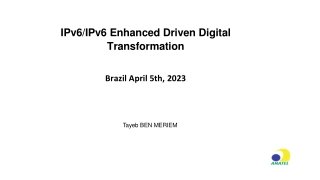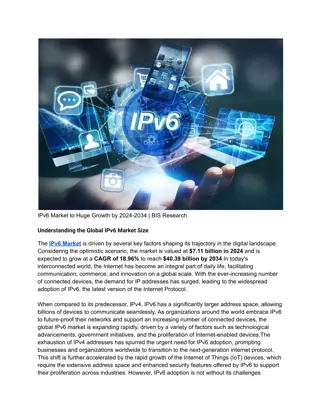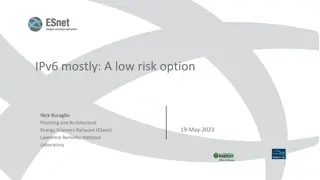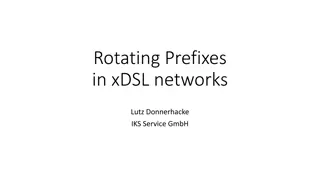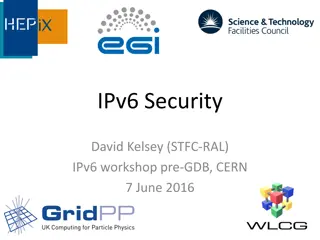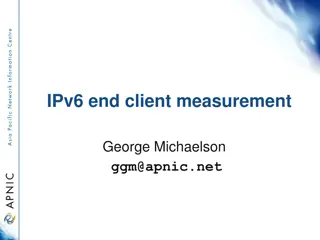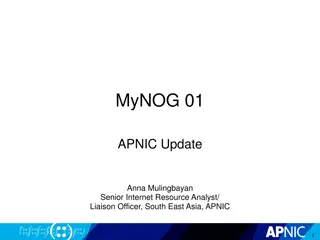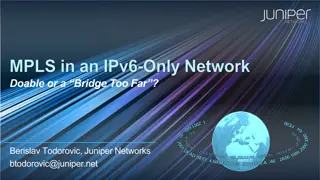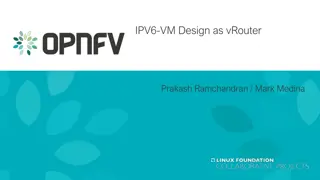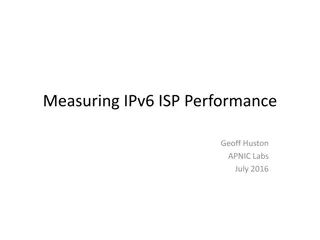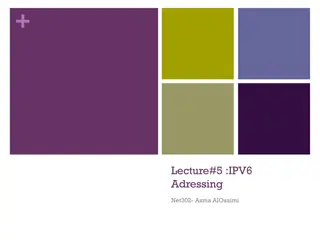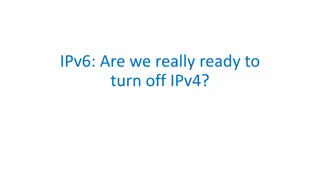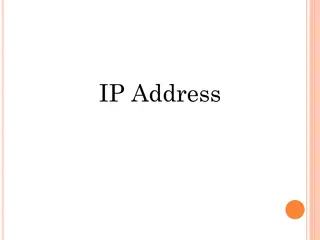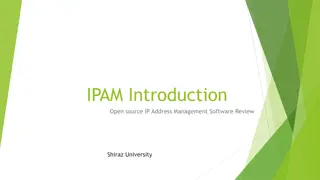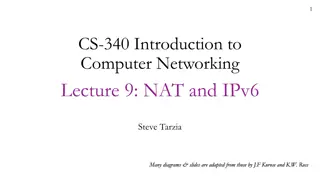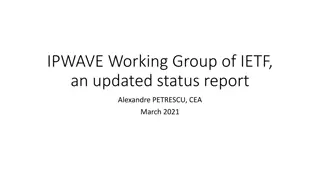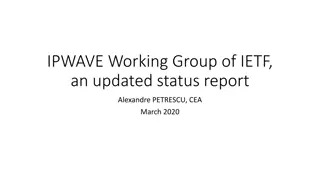Getting Started With IPv6
Delve into the world of IPv6 with insights on the Internet's growth, exhaustion of IPv4, benefits, major services, adaptation challenges, and differences from IPv4. Discover the need, significance, and implementation of IPv6 in today's evolving digital landscape.
Download Presentation

Please find below an Image/Link to download the presentation.
The content on the website is provided AS IS for your information and personal use only. It may not be sold, licensed, or shared on other websites without obtaining consent from the author.If you encounter any issues during the download, it is possible that the publisher has removed the file from their server.
You are allowed to download the files provided on this website for personal or commercial use, subject to the condition that they are used lawfully. All files are the property of their respective owners.
The content on the website is provided AS IS for your information and personal use only. It may not be sold, licensed, or shared on other websites without obtaining consent from the author.
E N D
Presentation Transcript
Getting Started With IPv6 Walter Horowitz Mardovar Networking LLC walter@mardovar.com
We Need IPv6 Exponential growth of the Internet and the exhaustion of the IPv4 address space IANA's exhaustion on January 31 2011, APNIC's exhaustion on April 15 2011 Growth of the Internet and the ability of Internet backbone routers to maintain large routing tables Need for simpler configuration Requirement for security at the IP level Need for better support for real-time delivery of data also called quality of service (QoS) New services may be IPv6 only, some already are Federal Government has mandated the use of IPv6
IPv6 is now alive on the Internet April 2011 - World IPv6 Test June 6, 2012 - IPv6 World Launch percentage of IPv6-enabled Autonomous Systems IPv6 connectivity to Google
Major Services In IPv6 > www.google.com Server: google-public-dns-a.google.com Address: 8.8.8.8 Non-authoritative answer: www.google.com internet address = 74.125.226.52 www.google.com internet address = 74.125.226.49 www.google.com internet address = 74.125.226.50 www.google.com internet address = 74.125.226.51 www.google.com internet address = 74.125.226.48 www.google.com AAAA IPv6 address = 2607:f8b0:4006:807::1011
Are You Using IPv6? Option in Windows XP, Linux since 2.1.8 Standard in Vista+, Linux 2.5.x and 2.6.x kernel MacOS X, Linux, BSD all prefer IPv6 Lion uses Happy Eyeballs (use fastest response) Windows HomeGroup breaks if you disable IPv6 DirectAccess and Remote Assistance require IPv6 Your devices may be IPv6 ready https://www.ipv6ready.org/
Differences Between IPv4 & IPv6 Feature Address length IPSec support QoS support Fragmentation Packet size Checksum in header Options in header Link-layer address resolution Multicast membership Router Discovery Uses broadcasts Configuration DNS name queries DNS reverse queries IPv4 32 bits Optional Some Hosts and routers 576 bytes Yes Yes ARP (broadcast) IGMP Optional Yes Manual, DHCP Uses A records Uses IN-ADDR.ARPA IPv6 128 bits Required Better Hosts only 1280 bytes No No Multicast Neighbor Discovery Message Multicast Listener Discovery (MLD) Required No Automatic, DHCP Uses AAAA records Uses IP6.arpa
IPv6 Address Format IPv6 address in binary form: 0010000000000001110110111000001100000000000000000010111100111011 0000001010101010000000001111111111111110001010001001110001011010 Divided along 16-bit boundaries: 0010000000000001 1101101110000011 0000000000000000 0010111100111011 0000001010101010 0000000011111111 1111111000101000 1001110001011010 Each 16-bit block is converted to hexadecimal and delimited with colons: 2001:DB83:0000:2F3B:02AA:00FF:FE28:9C5A Suppress leading zeros within each 16-bit block: 2001:DB83:0:2F3B:2AA:FF:FE28:9C5A
Compress One Block of Zeros Some IPv6 addresses contain long sequences of zeros A single contiguous sequence of 16-bit blocks set to 0 can be compressed to :: (double-colon) Example: FE80:0:0:0:2AA:FF:FE9A:4CA2 becomes FE80::2AA:FF:FE9A:4CA2 FF02:0:0:0:0:0:0:2 becomes FF02::2 Cannot use zero compression to include part of a 16-bit block FF02:30:0:0:0:0:0:5 does not become FF02:3::5
Key Address Prefixes Prefix Allocation Example 2000::/3 to 3fff Global Unicast 2002:AB::16/64 2001::DB8::/32 to 2001:DB8:FFFF Documentation Prefix 2001:DB8:AA::/64 FC00::/7 to FDFE Unique Local Unicast FC00:AB::7/64 FE80::/10 to FEBF Link Local Unicast FE80::6AEF:BDFF:FE61:4D13 FF00::/8 to FFFF Multicast FF01::1 All nodes int f FF02::2 All routers on link FF05::2 All routers at site ::FFFF/96 IPv4 Mapped Used to embed IPv4 addresses in an IPv6 ::/128 is the unspecified address ::1/128 is the loopback address
Types of IPv6 Addresses Unicast Address of a single interface One-to-one delivery to single interface Multicast Address of a set of interfaces One-to-many delivery to all interfaces in the set Anycast Address of a set of interfaces One-to-one-of-many delivery to the closest interface No more broadcast addresses
Aggregatable Global Unicast Addresses Top-Level Aggregation ID (TLA ID) /16 Next-Level Aggregation ID (NLA ID) /48 or /56 Site-Level Aggregation ID (SLA ID) /64 Interface ID (MAC derived?) 13 bits 8 bits 24 bits 16 bits 64 bits 001 TLA ID Res NLA ID SLA ID Interface ID
Link-Local Addresses Format Prefix 1111 1110 10 FE80::/64 prefix Used for local link only Single subnet, no router Address autoconfiguration Neighbor Discovery 10 bits 54 bits 64 bits 1111 1110 10 000 . . . 000 Interface ID
IPv6 Addresses for a Host Unicast addresses: A link-local address for each interface Unicast addresses for each interface (unique-local or global addresses) A loopback address (::1) Multicast addresses: The node-local scope all-nodes multicast address (FF01::1) The link-local scope all-nodes multicast address (FF02::1) The solicited-node address for each unicast address The multicast addresses of joined groups
IPv6 Interface Identifiers The last 64 bits of unicast IPv6 addresses Interface identifier based on: Extended Unique Identifier (EUI)-64 address Either assigned to a network adapter card or derived from IEEE 802 addresses Temporarily assigned, randomly generated value that changes over time A value assigned by a stateful address configuration protocol A value assigned during a Point-to-Point Protocol connection establishment A manually configured value
Conversion of an IEEE 802 Address to an EUI-64 Address IEEE-administered company ID Manufacturer-selected extension ID 24 bits 24 bits ccccccug cccccccc cccccccc xxxxxxxx xxxxxxxx xxxxxxxx IEEE 802 Address ccccccUg cccccccc cccccccc xxxxxxxx xxxxxxxx xxxxxxxx 11111111 11111110 0xFF 0xFE EUI-64 Address Complement the universally/locally administered (U/L) bit
Plan for your IPv6 Move Obtain an IPv6 Network Address Enable Dual Stack in machines Plan for your Network subnets Enable IPv6 in Routers Enable IPv6 in Services DNS DHCP Mail
How to Get an IPv6 Address Ask your ISP You should get a /48 address block - 65,536 subnets You can get a bigger block if necessary Home users may get less /52 4096 subnets, /56 is 256 http://www.tunnelsup.com/subnet-calculator Ask your Regional Internet Registry For Multihoming sites only, multiple ISP Test with a Tunnel Broker Hurricane Electric SixXs.net gogo6.com
Plan Your Address Allocation Expect significant growth for each subnet Use a good tool https://osl.uoregon.edu/redmine/projects/netdot http://sourceforge.net/projects/haci/ Others Get a manual http://www.ripe.net/lir-services/training/material/IPv6- for-LIRs-Training-Course/Preparing-an-IPv6-Addressing- Plan.pdf
Transitional Technologies 6to4 Not recommended http://tools.ietf.org/html/draft-ietf-v6ops-6to4-to-historic-05 6over4 Requires IPV4 multicast not worth your time ISATAP Uses DNS to find potential routers, Intra-Site only Teredo Tunnel IPv6 packets within UDP Does your ISP support 6rd? (IPv4 tunnel) NAT64/DNS64 NAT only IP4 only sites Dual Stack is Preferred Code for Happy Eyeballs
Add IPv6 to a router Cisco ipv6 unicast-routing Ipv6 cef Interface x Ip v6 address x/y (e.g. 2001:db8::2345.2345/126) ipv6 route address/bits interface ipv6 route ::/0 Serial2/0 (i.e. default route to Serial 2/0) Tunnel if necessary Insure you have correct Firewall rules
DNS and IPv6 Don t give out IPv6 addresses if you can t reach them. AAAA records for IPv6 name to address resolution IP6.arpa type PTR records for address lookup http://www.zytrax.com/books/dns/ch3/#ipv6-calculator Test for IPv6 capability http://test-ipv6.com/ (Cox talks about having IPv6, Verizon started 2013)
DHCP and IPv6 Not required stateless address assignment Do you want to be able to trace problems back to a specific user? Windows 7+, Mac OSX 10.7+ use Privacy Extensions by default. PE can be Enabled in Linux, default disabled in Ubuntu net.ipv6.conf.eth0.use_tempaddr=2 Available in Windows Server 2008 R2 & Linux Set DNS Recursive Name Server Domain Search List
Linux and IPv6 HOWTO at http://www.tldp.org/HOWTO/Linux+IPv6-HOWTO/ Is your kernel IPv6 ready? test -f /proc/net/if_inet6 && echo "kernel is IPv6 ready modprobe ipv6 Commands ping6 & traceroute6 (from iputils) eg. ping6 ff02::1
Free IPv6 Certification https://ipv6.he.net/certification/ Prove that you have IPv6 connectivity Prove that you have a working IPv6 web server Prove that you have a working IPv6 email address Prove that you have working forward IPv6 DNS Prove that you have working reverse IPv6 DNS for your mail server Prove that you have name servers with IPv6 addresses that can respond to queries via IPv6 Prove your knowledge of IPv6 technologies through quick and easy testing


